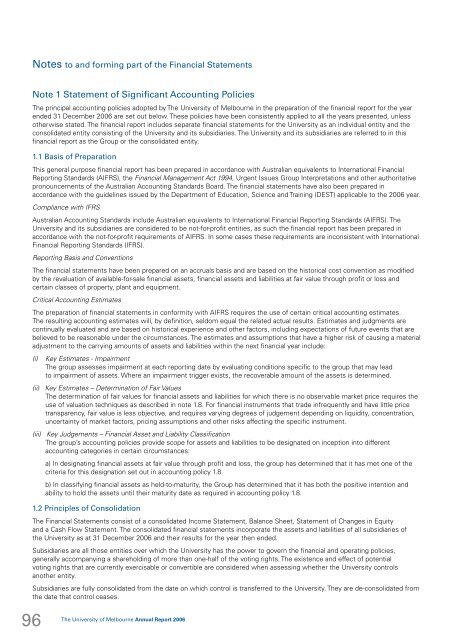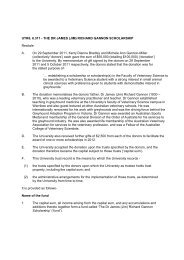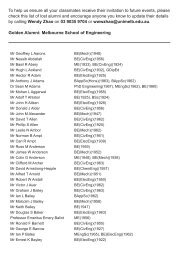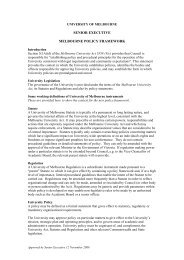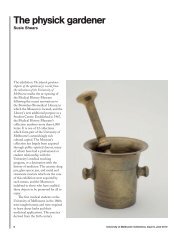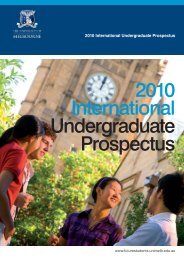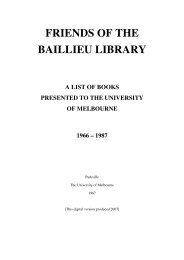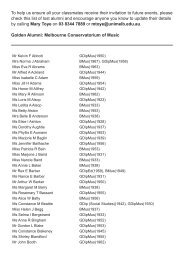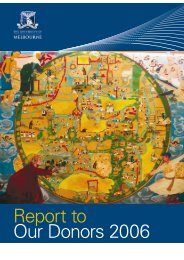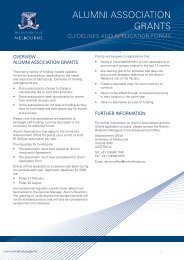annual report/2006 - University of Melbourne
annual report/2006 - University of Melbourne
annual report/2006 - University of Melbourne
Create successful ePaper yourself
Turn your PDF publications into a flip-book with our unique Google optimized e-Paper software.
Notes to and forming part <strong>of</strong> the Financial Statements<br />
Note 1 Statement <strong>of</strong> Significant Accounting Policies<br />
The principal accounting policies adopted by The <strong>University</strong> <strong>of</strong> <strong>Melbourne</strong> in the preparation <strong>of</strong> the financial <strong>report</strong> for the year<br />
ended 31 December <strong>2006</strong> are set out below. These policies have been consistently applied to all the years presented, unless<br />
otherwise stated. The financial <strong>report</strong> includes separate financial statements for the <strong>University</strong> as an individual entity and the<br />
consolidated entity consisting <strong>of</strong> the <strong>University</strong> and its subsidiaries. The <strong>University</strong> and its subsidiaries are referred to in this<br />
financial <strong>report</strong> as the Group or the consolidated entity.<br />
1.1 Basis <strong>of</strong> Preparation<br />
This general purpose financial <strong>report</strong> has been prepared in accordance with Australian equivalents to International Financial<br />
Reporting Standards (AIFRS), the Financial Management Act 1994, Urgent Issues Group Interpretations and other authoritative<br />
pronouncements <strong>of</strong> the Australian Accounting Standards Board. The financial statements have also been prepared in<br />
accordance with the guidelines issued by the Department <strong>of</strong> Education, Science and Training (DEST) applicable to the <strong>2006</strong> year.<br />
Compliance with IFRS<br />
Australian Accounting Standards include Australian equivalents to International Financial Reporting Standards (AIFRS). The<br />
<strong>University</strong> and its subsidiaries are considered to be not-for-pr<strong>of</strong>it entities, as such the financial <strong>report</strong> has been prepared in<br />
accordance with the not-for-pr<strong>of</strong>it requirements <strong>of</strong> AIFRS. In some cases these requirements are inconsistent with International<br />
Financial Reporting Standards (IFRS).<br />
Reporting Basis and Conventions<br />
The financial statements have been prepared on an accruals basis and are based on the historical cost convention as modified<br />
by the revaluation <strong>of</strong> available-for-sale financial assets, financial assets and liabilities at fair value through pr<strong>of</strong>it or loss and<br />
certain classes <strong>of</strong> property, plant and equipment.<br />
Critical Accounting Estimates<br />
The preparation <strong>of</strong> financial statements in conformity with AIFRS requires the use <strong>of</strong> certain critical accounting estimates.<br />
The resulting accounting estimates will, by definition, seldom equal the related actual results. Estimates and judgments are<br />
continually evaluated and are based on historical experience and other factors, including expectations <strong>of</strong> future events that are<br />
believed to be reasonable under the circumstances. The estimates and assumptions that have a higher risk <strong>of</strong> causing a material<br />
adjustment to the carrying amounts <strong>of</strong> assets and liabilities within the next financial year include:<br />
(i)<br />
Key Estimates - Impairment<br />
The group assesses impairment at each <strong>report</strong>ing date by evaluating conditions specific to the group that may lead<br />
to impairment <strong>of</strong> assets. Where an impairment trigger exists, the recoverable amount <strong>of</strong> the assets is determined.<br />
(ii) Key Estimates – Determination <strong>of</strong> Fair Values<br />
The determination <strong>of</strong> fair values for financial assets and liabilities for which there is no observable market price requires the<br />
use <strong>of</strong> valuation techniques as described in note 1.8. For financial instruments that trade infrequently and have little price<br />
transparency, fair value is less objective, and requires varying degrees <strong>of</strong> judgement depending on liquidity, concentration,<br />
uncertainty <strong>of</strong> market factors, pricing assumptions and other risks affecting the specific instrument.<br />
(iii) Key Judgements – Financial Asset and Liability Classification<br />
The group’s accounting policies provide scope for assets and liabilities to be designated on inception into different<br />
accounting categories in certain circumstances:<br />
a) In designating financial assets at fair value through pr<strong>of</strong>it and loss, the group has determined that it has met one <strong>of</strong> the<br />
criteria for this designation set out in accounting policy 1.8.<br />
b) In classifying financial assets as held-to-maturity, the Group has determined that it has both the positive intention and<br />
ability to hold the assets until their maturity date as required in accounting policy 1.8.<br />
1.2 Principles <strong>of</strong> Consolidation<br />
The Financial Statements consist <strong>of</strong> a consolidated Income Statement, Balance Sheet, Statement <strong>of</strong> Changes in Equity<br />
and a Cash Flow Statement. The consolidated financial statements incorporate the assets and liabilities <strong>of</strong> all subsidiaries <strong>of</strong><br />
the <strong>University</strong> as at 31 December <strong>2006</strong> and their results for the year then ended.<br />
Subsidiaries are all those entities over which the <strong>University</strong> has the power to govern the financial and operating policies,<br />
generally accompanying a shareholding <strong>of</strong> more than one-half <strong>of</strong> the voting rights. The existence and effect <strong>of</strong> potential<br />
voting rights that are currently exercisable or convertible are considered when assessing whether the <strong>University</strong> controls<br />
another entity.<br />
Subsidiaries are fully consolidated from the date on which control is transferred to the <strong>University</strong>. They are de-consolidated from<br />
the date that control ceases.<br />
96<br />
The <strong>University</strong> <strong>of</strong> <strong>Melbourne</strong> Annual Report <strong>2006</strong>


